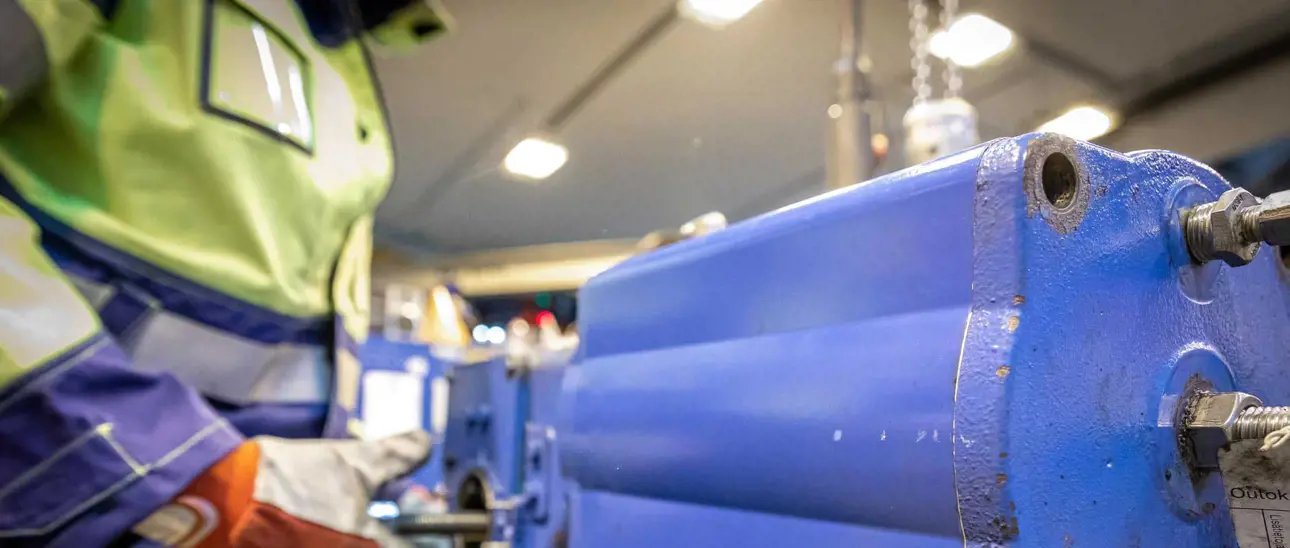12 recommendations to minimize capital project start-up problems and lower total cost of ownership
Nov 24, 2021
Valves are a major investment, in every sense of the word, for process industry brownfield and greenfield projects. Particular attention is given to valves in severe, operation-critical, and safety-critical applications – products on which Valmet's flow control business has built its reputation – to ensure a timely and successful plant start-up. Read on to see our expert's recommendations.

The complexity of modern projects and the sheer volume of equipment, documents and discrete activities put a greater emphasis today on early planning and good practices to minimize costly mistakes and productivity bottlenecks. Project teams coordinating and controlling the work of site contractors and sub-contractors are also smaller than in the past.
For Valmet's valve owners, the objective is to:
a) establish that valves have been installed exactly as they should be, commissioned and put into operation smoothly, safety, on time and on budget, and with minimal complications or damage
b) ensure operations and maintenance are given the right training, documents, data, tools, procedures and spares inventory to run the plant.
It’s also important to consider capital project valves as assets that need to be managed well over 15 years. Startup and the first months of operation have a disproportionate impact on the lifetime and performance of valves as well as on Total Cost of Ownership (TCOO).
Since 1975, our service teams have worked closely at site with EPCs and end user plants toward smooth and successful start-up of a few large capital projects globally.
These 12 recommendations draw from years of project experience, and are given in customary chronological order, but also come in response to growing interest in this topic in recent years.
We also share the belief that successful commissioning, startup and handover of our valves is everyone’s gain and an integral element of our dedication to excellence in capital projects.
1. Safety always comes first: make sure teams at site understand risks and good handling practices
Capital projects are typically supported by several contractors and subcontractors who need to understand the inherent risks associated with handling process equipment – among others, our valve assemblies – with moving parts, varying weight and product-specific lifting and adjusting instructions. Risks and instructions are detailed in Installation, Maintenance and Operation (IMO) manuals. Good and safe handling practices also protect your investment from damage and voided warranties.
2. Communication is key: liaise with your local Valmet flow control service point-of-contact
It’s well known that effective communication plays a critical role in the success of a project. As project teams “hand over” deliverables, knowhow, and responsibility from one to another, it is important to ensure a continuous line of communication with key Original Equipment Manufacturers (OEM). After valves leave factory, our service teams become the main point-of-contact locally.
For projects with potentially large Valmet's valve scopes we recommend involving a service specialist during the main equipment quotation process and holding a meeting, after contract signing, to align on needs and plan support at site. In any event, our project sales process warrants the involvement of service specialists to address questions regarding start-up, support at site and lifecycle planning early on.
3. Arrange adequate storage and ask us for advice in case of prolonged storage
It’s in the valve owner’s interest to plan storage before the valves arrive at site to preclude sources of deterioration such as condensation from inside and particulate (for example: dust, sand, dirt) or moisture contamination from outside. Detailed Valmet recommendations are available. We recommend products be stored in their closed original transportation boxes with plastic covers kept intact until installation.
Depending on the local climate and on project-specific requirements, you may need to store the boxes themselves in an air-conditioned warehouse or on dry solid ground covered from the rain. Soft-seated valves should be kept in a fully open or fully closed position since long-term storage in the partially open position can permanently damage the seat. If the project is delayed, Valmet's flow control experts can advise how to maintain the integrity of your asset over prolonged periods of storage.
4. Prepare for contigencies with the right amount of commissioning spares at hand
Good planning, high quality products, thorough quality control processes and competent staff may not eliminate minor installation, commissioning, or startup challenges altogether. Pneumatic instrumentation can be accidentally damaged for instance, and the cost of a few spares is not worth the risk of waiting for replacements. This is particularly for projects in remote locations. We can support to plan commissioning and start-up spares.
5. Check for signs of contamination or damage, detect issues early
It’s a good practice to inspect valves before and after installation even if strict precautions were taken during transportation, storage, and handling. The earlier problems are detected the cheaper and easier they are to correct. If the project is delayed or valves already installed on the pipeline need to be cocooned or put in preservation mode, we can advise how to maintain the integrity of your asset over prolonged periods of inactivity.
6. Flush the pipeline carefully
Ensure that no dirt, sand, or foreign object (welding rods, bolts) is left inside pipeline before flushing as this could damage closing element and seat surfaces. If it is not possible to remove valves for flushing, ball valves should be kept fully open and butterfly valves at a 30–40-degree angle to avoid trapping of contaminants and reduce friction.
Special precautions should be taken when flushing the pipeline with fluids with high acid concentration as these can, for instance, damage hard-chrome or tungsten carbide coatings. Check the type of liquid and the level of concentration and flush the pipeline again with pure water to get rid of any acid inside the valves.
7. Ensure correct installation and connection in compliance with Neles manuals
Installing, mounting, connecting, adjusting, and calibrating Valmet valves, actuators and smart devices is straightforward. Detailed instructions, as well as advice for correct support and insulation, are given in the Installation, Maintenance and Operation (IMO) manuals. Over the years we have nevertheless observed valve mounted backward, putting unnecessary stress to piping, incorrectly mounted to fit odd space configurations, etc. Although relatively rare, improper installation may reduce asset lifetime, affect performance, and compromise the accuracy of diagnostics.
Expert supervision guarantees correct installation in compliance with Valmet best practices. Keep in mind modifications at site (for example: changing actuator orientation) should be performed by our competent service specialist so as not to invalidate warranty.
8. Consider the net benefit of expert supervision to support your site teams and resolve issues faster
Time is a precious commodity at site. Consider the math’s of:
a) the cost of our expert supervision
b) the added value of minimizing delays at site
c) the added value of protecting your long-term investment.
Our flow control experts help warrant work standards of the highest quality, implement good practices, and solve issues faster.
Our flow control experts help warrant work standards of the highest quality, implement good practices, and solve issues faster. They also allow your teams to focus on other responsibilities whilst establishing daily reporting. As an example, we mobilized two dedicated flow control service technicians at site for over a year to cover the late stages of a large petrochemical project in Asia, with additional technicians brought in during commissioning.
9. Identify poorly behaving control loops early to achieve stable process conditions and targeted yields as quickly as possible
As the plant moves to initial start-up focus turns to reaching stable, on-spec production as fast as possible. It’s important to stabilize critical control variables as early as possible to prevent damage to equipment, prevent interlock activation and avoid safety and environmental incidents. Having said that, control engineers and startup teams typically spend most of their time independently fighting fires and remediating problems.
Expertune PlantTriage automated loop tuning, and diagnostics allows project teams to catch process performance issues early on (mainly those related to control valves), prioritize remediation and speed up loop tuning to reach target levels in record time.
10. Arrange training for operation and maintenance teams, particularly with regards to critical valves and intelligent devices
It’s common for training to be offered as a contract option. However, our experience at a site is that training is often overlooked once other things take priority at commissioning and start-up stage. Ensuring operations and maintenance teams are adequately prepared helps you protect your investment. So does making the most of available diagnostics to monitor condition online and support predictive maintenance. We can offer custom training on installation, operation, inspection, maintenance, and diagnostics interpretation.
11. Ensure systems are set up with correct data and recommendations from day one and make full use state-of-the-art tools
By the time the plant has been handed over to operations and maintenance, you ideally want to make certain that a) systems are set up with correct and complete “static” data b) good practices and procedures are in place to gather, combine and interpret “dynamic” data generated by valves and control loops.
We can provide custom recommendations and take an active role in maintenance planning, condition monitoring, shutdowns planning, etc., at site or remotely. All these services can be written into the scope of a local Service Center agreement or “resident” technician.
12. Leverage data to build a spares inventory that optimally matches operations and maintenance needs
Selecting what to keep in inventory to keep the plant running at high availability is a difficult balance between managing risks and minimizing capital tied up in spares. We can support toward optimal visibility on criticality, interchangeability, factory lead times and historical data benchmarked from similar plants. Also consider long-term solutions to actively confirm your inventory matches needs and consumption.
Finally, it’s important to provide adequate storage conditions for spares, particularly soft parts whose shelf life can be reduced by inadequate storage. Our detailed recommendations are available, and all these services can be written into the scope of a local Service Center agreement or “resident” technician.
The text has been updated in April 2022, due to the company name change to Valmet.
Expert

Subscribe to our newsletter
Subscribe now to our 'Go with the flow' newsletter and receive the latest insights directly to your email.
SubscribeRead more about the topic and Neles' services


![The [valve] parts make the whole](/globalassets/flow-control/old-neles-times/old-neles-time-images/investors/return-and-dividents.jpg?format=webp&width=650&quality=70)

